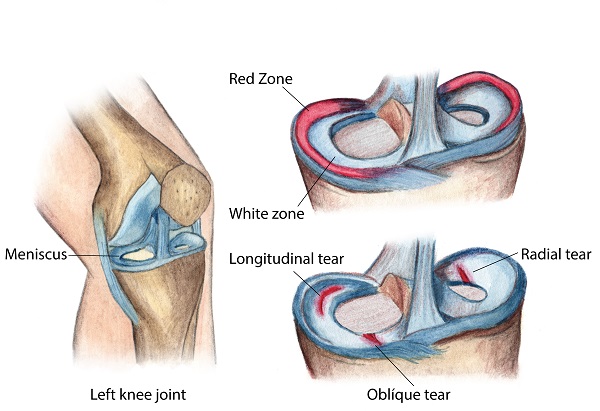Torn Meniscus: How Long Does It Take to Heal?

Updated August 23, 2023
A torn meniscus can be a painful, debilitating injury. Even worse, your injury may be the result of a violent car crash or work accident, leaving you unable to drive, work efficiently, or pursue the normal activities and hobbies you enjoy.
A severe knee injury involving a meniscus tear may require expensive surgery and physical therapy, which most can’t afford. If the insurance company is giving you trouble, contact Gary Martin Hays & Associates for a free consultation to review your legal options and your rights.
Meniscus Tear Causes
The medial and lateral menisci are two C-shaped pieces of cartilage that act like cushions between the shinbone and thighbone (meniscus comes from the Greek words mēniskos ‘crescent’ and mēnē ‘moon’).
A meniscus tear can happen due to trauma caused by a sudden twist, hyper-extension, or hyperflexion of the knee joint. Knee injuries most commonly occur while kneeling, squatting, or lifting something heavy.
Age and obesity can increase a person’s risk of suffering a torn meniscus.
Types of Meniscus Tears
When a meniscus tears, the lack of protective cushioning allows the shin and thigh bones to rub against each other, causing inflammation, stiffness, and lack of function.

There are six main ways a meniscus can become injured:
- Bucket handle tear - Cartilage looks O-shaped instead of C-shaped. The knee becomes stuck, with the tear blocking the ability to bend. Urgent surgery is often needed to restore the knee’s ability to bend and prevent scar tissue from forming.
- Complex tear - This injury involves several tears, usually radial and horizontal. Reparative surgery isn’t typically done, but the entire meniscus may be removed if necessary.
- Degenerative tear - The meniscus looks worn away or shredded in places. Surgery is often not required.
- Flap tear - A rip or split that causes part of the meniscus to become slightly detached. It often causes a catching sensation in the knee. Removing the damaged tissue may help resolve any pain.
- Horizontal tear - This tear is close to the edge of the meniscus and is one of the easiest meniscus injuries to repair. If surgery is needed, the surgeon may be able to sew the fibers together instead of trimming them.
- Radial tear - A partial or complete tear that bisects the cartilage. This is the most common type of tear and cannot heal on its own due to a lack of blood supply to the area. Surgery may be required if the tear is severe.
Meniscus Injury Symptoms
It may or may not be obvious when a knee joint has been injured. Some people are still able to walk on the injured limb. You might feel a pop when the meniscus tears or notice an increased difficulty and discomfort in movement or walking.
Signs that you’ve torn your meniscus include:
- Swelling
- Stiffness
- Lack of stability (giving way)
- Limited motion
- Limping
- Popping
- Locking
Without treatment, there will likely be complications later. Pieces of the meniscus may come loose and jam the knee joint. Or the knee joint becomes unstable, increasing the risk of other knee injuries such as an ACL tear.
Do not ignore pain and discomfort in your knee. Rest and seek treatment to prevent further complications.
Treating a Torn Meniscus
Treatment depends on the size and location of the tear(s).
Standard treatments like ice, extended rest from work and travel, and over-the-counter pain relievers are sometimes enough to help the injury heal on its own. Severe tears — especially those that are large, unstable, or cause locking — may require surgical repair.
A doctor may order an X-ray to see if the patella (knee bone) is broken or if you have osteoarthritis. An MRI scan can provide a more detailed view of the injured cartilage and other soft tissues in and around the knee.
A doctor may also perform the McMurray test. They will bend the knee, then straighten and rotate it. If you have a meniscus tear, the tension will cause a clicking sound during the test.
The meniscus can be divided into two “zones”: red and white. The red zone has access to an ample blood supply — if the tear here is small, it can sometimes heal on its own. The white zone on the other hand, which is the largest part of the meniscus, lacks a good blood supply to bring it the necessary nutrients needed to heal.
A doctor or specialist will be the best judge of the severity of the meniscus tear and the treatment plan needed for a full recovery.
Arthroscopic Surgery
An orthopedic surgeon may recommend a knee arthroscopy. This is a minimally invasive procedure used to treat meniscal tears. A tiny camera is inserted through a small incision made near the joint. Images are relayed to a screen so the surgeon can suture or trim the torn portions of the injured meniscus.
One way to speed up recovery, regardless of whether you need surgery, includes following the RICE protocol:
- Rest - Limit your movement to walking. Use crutches to help alleviate pain.
- Ice - Cold helps reduce pain and swelling in the early stages of the injury. Ice every 15-20 minutes for three to four hours a day for the first few days.
- Compress - To control swelling, you can try wrapping the knee with an elastic band or knee brace.
- Elevate - Place a pillow or blanket under your heel or leg when sitting or lying down.
Anti-inflammatory drugs can help reduce pain and swelling but can have side effects.
Your doctor will likely recommend a physical therapist to visit or exercises to do at home to stretch and strengthen the leg and joints. Keeping an aggressive and regular physical therapy schedule will improve your meniscus tear recovery time and healing.
Recovering After a Torn Meniscus
Torn meniscus recovery time varies depending on the severity of the tear and how well a person heals. Rehabilitation after surgery can take anywhere from three to eight weeks.
It may be tempting to return to old activities that involve running or jumping, but doing so could re-aggravate or re-injure your knee. You shouldn’t return to pre-injury levels of activity until you can do the following:
- Fully bend and straighten the knee without pain
- Feel zero pain when walking, jogging, sprinting, or jumping
- Observe no swelling
- Sense that the injured knee feels the same as the uninjured knee
Most people who suffer a meniscus tear can return to full activity without pain after several weeks. If surgery is needed, a few months of physical therapy should help the knee fully recover.
Knee Injury Lawyer - Gary Martin Hays & Associates
Maybe you injured your knee at work while lifting boxes or fell and twisted it due to unsafe working conditions. Perhaps you were driving or walking when you were suddenly struck by a vehicle. Now you’re in the emergency room or talking to a doctor, in pain and worried about medical care.
Our Atlanta personal injury and workers’ compensation lawyers are available to help. We make sure the insurance company is treating you fairly and that your claim is taken seriously.
Knee injuries can be painful and frustrating, costing you time, money, and work opportunities. Dealing with the insurance company and its layers of bureaucracy is another burden you shouldn’t have to deal with on your own.
Give Gary Martin Hays & Associates a call. Our team of experts has handled many cases involving knee injuries, including meniscus tears, broken knees, and complete knee replacements.
(770) 934-8000
Further Reading
Getting Workers' Compensation For An On-The-Job Meniscus Tear

 Find a location near you
Find a location near you